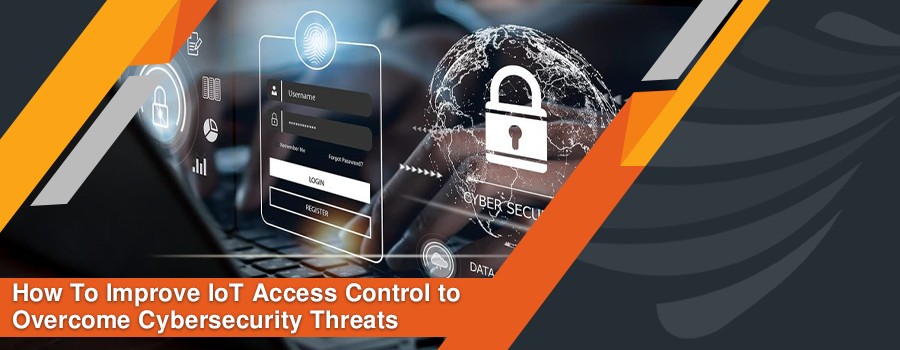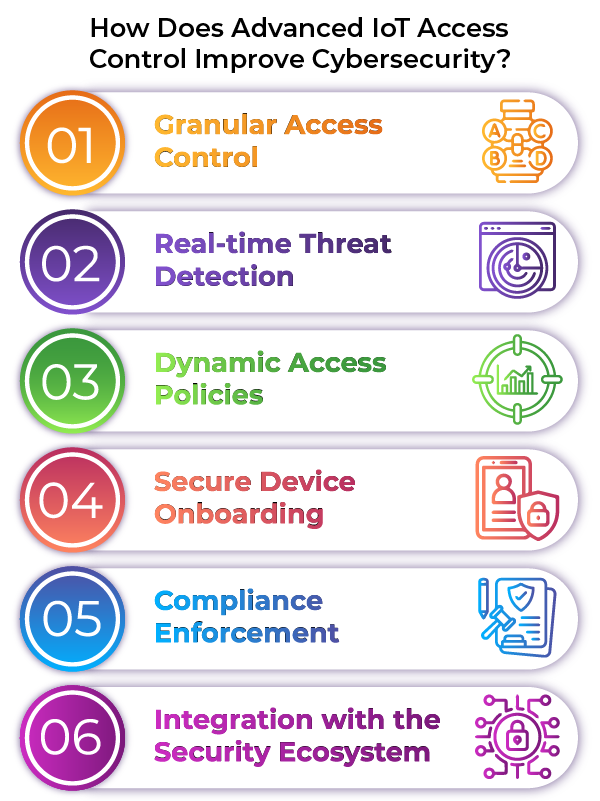The Internet of Things (IoT) has completely revolutionized the way we used to live. From connected cars to smart home appliances, these devices have added convenience and automation. Installing IoT devices while advancing our lives creates vulnerabilities that malicious actors can exploit.
Many IoT devices lack robust security features, making them susceptible to breaches that could compromise personal data, invade privacy, or even threaten critical infrastructure. Without adequate safeguards, hackers can gain control over household cameras, access sensitive passwords, and easily exploit digital assets.
However, there’s no need for undue alarm. This blog brings you reassuring news and actionable insights. Join us as we delve into the intricacies of fortifying IoT access control systems to combat cybersecurity threats effectively. Together, we’ll explore the best practices and strategies to safeguard our interconnected world and ensure a safer digital future.
What is IoT Access Control?
IoT access control is a critical cybersecurity measure that monitors and controls access to IoT systems and devices. It lets administrators control how people and devices behave within an IoT ecosystem. This includes defining user roles, allowing or refusing access to the system, and limiting access to resources as required.
The growth in IoT access control reflects its advantages. The market size for this technology is expected to reach $29.3 billion by 2024, up from $10.2 billion in 2020. This significant rise indicates a growing adoption of this technology due to its enhanced security, improved convenience, and scalability.
Due to their constantly changing nature, IoT technologies create serious cybersecurity vulnerabilities by default. Malicious actors can exploit IoT device flaws to obtain unauthorized access to sensitive data and information they collect. They can compromise a single device in a network, breaching the entire system. IoT access control uses several tiers of cybersecurity protections to lessen these risks, which lowers the possibility that nefarious actors would obtain vital resources and risk system integrity.
How is IoT used in Access Control Systems?
IoT plays a major role in access control systems and enables interconnected and intelligent operations. Here is how IoT is utilized in such systems:
1. Device Connectivity
IoT makes linking different access control parts to a network easier, including controllers, card readers, locks, and sensors. Since every device has a distinct IP address, data sharing, and communication are made possible without difficulty.
2. Centralized Management
IoT makes it possible to operate access control systems centrally via cloud-based apps or software platforms. This centralization allows Administrators to monitor and control user credentials, system settings, and access rights from a single interface.
3. Real-time Monitoring
IoT allows for real-time monitoring of access control actions. The system’s built-in sensors and cameras can recognize unusual activity or attempts at unauthorized entry and notify administrators immediately.
4. Remote Access and Control
Thanks to the Internet of Things, users can access and control the access control system remotely through web Interfaces or Mobile Applications. With this feature, users may access system status, open doors, and grant or cancel access permissions from any location with an internet connection.
5. Data Analytics and Insight
Access control systems with IoT capabilities can gather and examine information about system performance, entry points, and user access patterns. This data can be used to find security flaws, improve access procedures, and increase system performance overall.
6. Integration with Other Systems
Integration with other smart building systems, like HVAC, lighting controls, and security cameras, is made easier by IoT. Improved security features, including automated reactions to security problems and video verification of access events, are made possible by this integration.
Challenges of IoT Access Control
Because of the peculiarities of IoT networks and devices, securing access control in the IoT ecosystem poses several difficulties. Among these difficulties are:
1. Resource Limitations
IoT devices frequently have constrained energy, storage, and processing capabilities. Because of their limited memory and processing power, these devices can have difficulty implementing strong authentication and access control systems.
2. Communication Overhead
Traditional authentication algorithms may impose a large communication overhead in IoT contexts with limited bandwidth, hindering the effective data interchange between IoT devices and authentication servers.
3. Physical Security Restraints
IoT devices, such as outdoor sensor networks or isolated industrial sites, are commonly placed in inaccessible locations. Providing physical security for these devices may not be feasible or feasible, leaving them open to theft or physical tampering.
4. Lack of Standardization
The absence of universal standards for IoT access control exacerbates the challenge of securing IoT deployments. With no uniform framework, organizations must navigate a fragmented landscape of proprietary solutions and protocols, leading to interoperability challenges and potential security gaps.
5. Device and Protocol Heterogeneity
The IoT comprises a wide range of devices made by many manufacturers that run on various hardware and software platforms. Due to this variety, interoperability problems between devices employing various protocols may occur, making deploying uniform access control techniques more difficult.
6. Scalability and Management
Keeping track of credentials and access control regulations becomes more difficult when IoT deployments grow to handle hundreds or even millions of devices. Many administrative and logistical obstacles must be overcome to ensure uniform implementation of access control policies throughout a dynamic and quickly growing Internet of Things environment.
4 Best Approaches to Improve IoT Access Control
Enhancing IoT access control requires considering various approaches designed to address the difficulties presented by IoT environments. The following four strategies aim to improve IoT access control:
1. Decentralized Access Control Systems
Decentralized Access Control Systems are security frameworks that distribute access control functions across a decentralized network, typically leveraging blockchain technology. Unlike traditional centralized access control systems, where a single authority or server makes access decisions, decentralized systems distribute control among multiple nodes or participants in the network. Each node maintains a copy of the access control policies and participates in the decision-making process through a consensus mechanism.
Decentralized Access Control Systems overcome the drawbacks of centralized models and improve scalability, robustness, and security by dispersing access control functions throughout a decentralized network. Decentralized techniques are ideal for managing large-scale IoT deployments across various contexts because they limit the danger of illegal access and remove single points of failure.
2. Device Identity Authentication
For efficient access control, IoT devices must establish distinct identities. Conventional techniques such as certificate-based authentication and IP or MAC address-based identification are examples of authentication methods. However, by examining static data and behavioral patterns, machine learning algorithms can greatly increase the accuracy of device identification. This dynamic authentication technique strengthens security even for IoT devices with limited resources by allowing adaptive access control decisions based on contextual criteria.
3. Attribute-Based Access Control (ABAC)
Attribute-based access control, or ABAC, assesses access requests using various attributes about the device, resource, action, and context. ABAC provides granular control over access permissions, enabling administrators to set policies according to characteristics like device type, location, or user role. This adaptable strategy improves security and compliance in Internet of Things environments by enabling real-time adjustments to access permissions in response to shifting contextual elements.
4. Role-Based Access Control (RBAC)
RBAC is a system that grants access permissions to devices or users based on specified roles established inside the company. By assigning user roles to certain access capabilities, RBAC makes it easier to administer and enforce access controls. Administrators can establish role hierarchies and access levels to guarantee that users are only granted access to the resources required for their specific responsibilities. RBAC is a useful strategy for Internet of Things systems with various user demographics since it simplifies access control administration and reduces the possibility of unwanted access.
How Does Advanced IoT Access Control Improve Cybersecurity?
Enhancing cybersecurity using more complex and dynamic safeguards for IoT networks and devices is made possible by advanced IoT access control. Advanced IoT access control improves cybersecurity in the following ways:
1. Granular Access Control
With advanced IoT access control, administrators may set up policies for granular access control dependent on variables like user roles, device identities, and contextual characteristics. This reduces the possibility of unwanted access or data breaches by guaranteeing that only authorized people and devices can access resources.
2. Real-time Threat Detection
Modern access control systems use machine learning algorithms and advanced analytics to monitor real-time IoT device behavior and network traffic patterns. This allows security personnel to identify suspicious activity or abnormalities early on, react quickly to possible threats, and reduce risks before they become more serious.
3. Dynamic Access Policies
In contrast to static access control models, sophisticated IoT access control systems enable dynamic access policies that can instantly adjust to contextual changes and shifting conditions. Because of this adaptability, administrators can modify access rights in response to variables like device location, time of day, or user activity, all while improving security and maintaining usability.
4. Secure Device Onboarding
Advanced access control systems include secure device onboarding procedures to guarantee that only reliable devices can connect to the Internet of Things. Before allowing access, this may entail methods like certificate-based authentication, mutual authentication, and secure bootstrapping processes to confirm the legitimacy and integrity of IoT devices.
5. Compliance Enforcement
By implementing access control rules that are compliant with relevant legislation, advanced IoT access control solutions assist enterprises in upholding industry standards and regulatory compliance obligations. This includes keeping audit records of access activities for compliance reporting needs, safeguarding sensitive data, and guaranteeing data privacy.
6. Integration with the Security Ecosystem
Threat intelligence feeds, SIEM platforms, intrusion detection systems, and other cybersecurity tools and technologies are all easily integrated with advanced access control solutions. As a result, businesses can more efficiently detect and address security incidents by comparing access control data with other security events and indications.
Final Thoughts
Improving IoT access control is essential to effectively mitigate cybersecurity threats in increasingly interconnected environments. Organizations can bolster their defenses against evolving cyber threats and safeguard IoT devices, networks, and data from unauthorized access and breaches. By implementing granular policies, real-time threat detection, and dynamic adaptation to contextual factors, IoT access control systems mitigate the risks of cyber-attacks.





